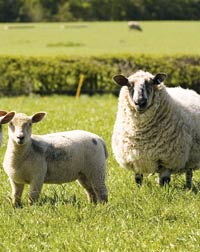New Irish sheep genetic index launched

With it becoming increasingly difficult for Irish sheep farmers to make a profit, Sheep Ireland, part of the Irish Cattle Breeding Federation, has launched a new genetic index to improve quality and lamb margins.
The new €uro-Star Profit Index, which was launched at this week’s Irish Grassland Association Sheep Conference, County Kilkenny, Ireland, aims to revolutionise the approach to lamb genetic improvement, said Patrick Donnellan, Irish Cattle Breeder Federation.
“The scheme will build a new profit index based on euros/lamb born and allow commercial farmers to identify the top performing rams on genetic worth.”
The new index has the same profit principles as the Economic Breeding Index and Beef €uro-Stars, with the ultimate aim to increase the quantity and quality of data for sheep breeding.
This replaces the Old Lean Meat Index, LMI, which proved unpopular among farmers and breeders, said Tim Byrne, New Zealand sheep scientist at AbacusBio. “The LMI was a relative index based on terminal sires only and compared data within breed and year.”
The €uro-Star Index will include
|
|---|
Sheep Ireland aims to develop breeding values for a wider range of performance traits with a higher emphasis on maternal performance. “To improve commercial ewe performance, we must focus more on maternal traits that will lead to lower cost and easy care sheep, alongside the established terminal traits of importance,” said Mr Byrne.
“This will lead to lower costs and real gains in profitability.”
The new €uro-star index uses genetic data gathered from both pedigree and commercial flocks giving extra information on both production, lambing and maternal traits. The index will also compare information across breeds and years.
Data is being collected from Maternal Lamb producers (MALP) and pedigree breeders (LambPlus) with 8000 commercial and 3000 pedigree ewes currently involved.
The MALP flocks are key to the success of €uro-star, said Mr Donnellan. “By using commercial flocks, we are starting where we need to end – this index must be relevant to commercial producers.”
The project is in its early days, but we have already demonstrated differences exist in commercial flocks, said Michael Gottstein, sheep specialist at Teagasc.
“This is an exceptional start to the scheme, but obviously we need to get as many farmers involved as possible to improve the accuracy and quality of data.”
“In order for the scheme to work we need commercial farmers to pay more for rams that have indices to encourage pedigree breeders to become more involved.”
